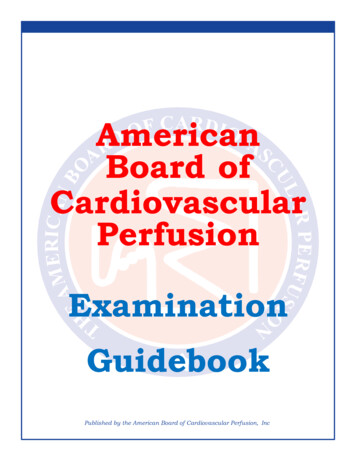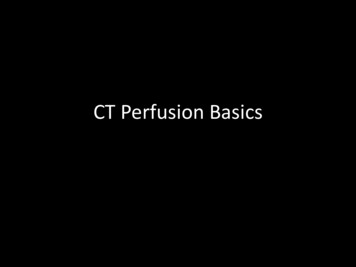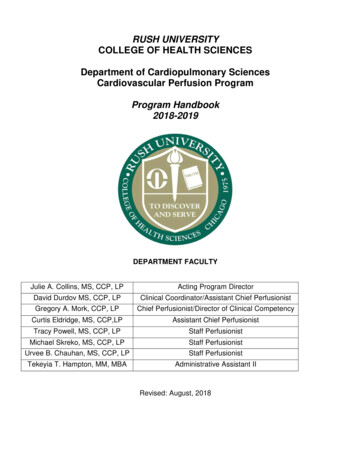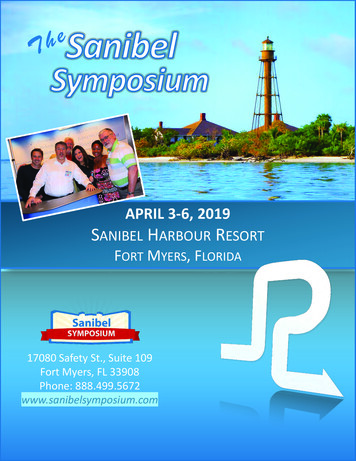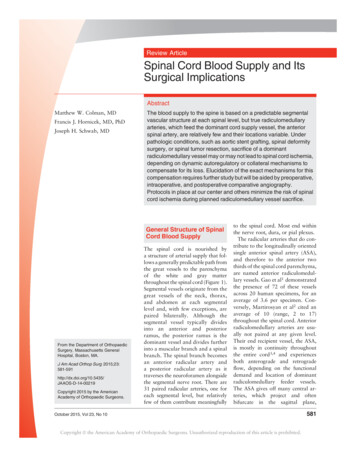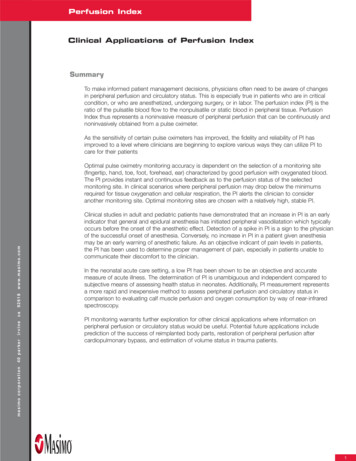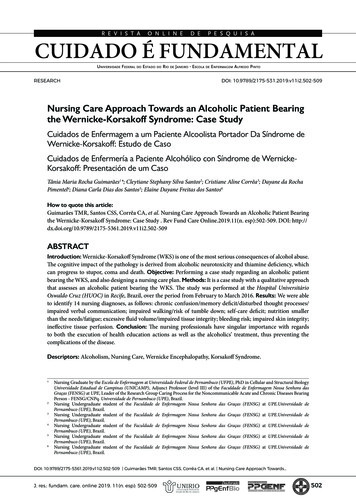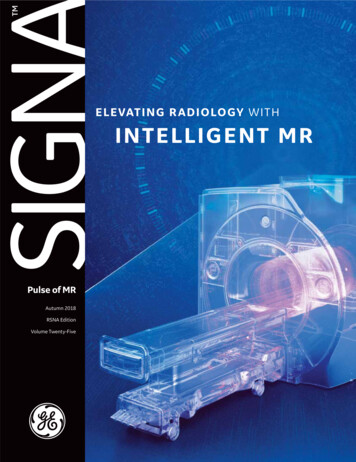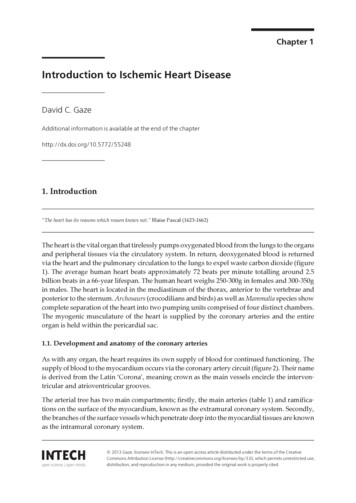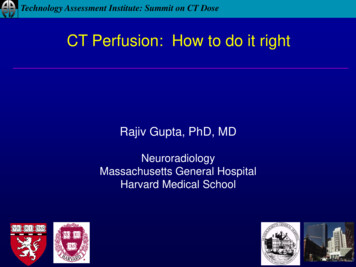
Transcription
Technology Assessment Institute: Summit on CT DoseCT Perfusion: How to do it rightRajiv Gupta, PhD, MDNeuroradiologyMassachusetts General HospitalHarvard Medical School
Technology Assessment Institute: Summit on CT DoseCT Perfusion has a role to play in top 3!CAD
Technology Assessment Institute: Summit on CT DoseOutline Application domains––––Stroke imagingVasospasmMyocardial ImagingTumor Imaging Basic CT PerfusionParadigm Neuro Perfusion––––MotivationTechniqueArtifacts and PitfallsDose Issues Myocardial Perfusion––––MotivationTechniqueArtifacts and PitfallsDose Issues
Technology Assessment Institute: Summit on CT DoseBasic ParadigmHUReferenceCurve (AIF, LV)NormaltissueIschemictissueTimeShort-axisObserve dynamic blood flow asthe contrast washes and out
Technology Assessment Institute: Summit on CT DoseParameterizationMax SlopeHUTTPCBF CBV/MTTCBVMTTBolusArrivaltimeTime
Technology Assessment Institute: Summit on CT DoseDensity [Iodine] Blood FlowGeorge et al. Quantification of myocardial perfusion using dynamic 64-detector computedtomography. Investigative radiology (2007) vol. 42 (12) pp. 815-22
Technology Assessment Institute: Summit on CT DoseSNR and CNRGeorge et al.Investigativeradiology (2007)ReferenceNormalIschemicNieman et al. Reperfused myocardialinfarction: contrast-enhanced 64-Section CTin comparison to MR imaging. Radiology(2008) vol. 247 (1) pp. 49-56
Technology Assessment Institute: Summit on CT DoseStenosis and Blood Flow
Technology Assessment Institute: Summit on CT DoseTwo mechanisms: Flow-dependence and stealRestStress
Technology Assessment Institute: Summit on CT DoseMain Challenges Too many technologies– CT scanners– Processing algorithms CNR and SNR are low Dose can be very high Clinical applications are still being worked outOther than that, life is good!
Technology Assessment Institute: Summit on CT DoseCT bleCheap(er)SlowPoor Z-axiscoverageFastZ-axis coverageTemporalinhomogeneityDual SourceWide-areaTemporal(320 MDCT) homogeneitySlowerHigh DoseFast!2nd GenBetter Z-axisDual Sourcecoverage5Triple Sourcemilliseconds,640 MDCTWhole heartStill not fullcoverage In my dreams
Technology Assessment Institute: Summit on CT DoseLow CNR and SNR50454035302520151050159 13 17 21 25 29 33 37 41 45 49 53 57 61 65 69 73 77 81 8536 HU44 HU
Technology Assessment Institute: Summit on CT DoseMRP vs. CTP: Single pixelGray eWhite MatterCT440-120MR10203040timeWAC/MGH
Technology Assessment Institute: Summit on CT DoseMRP vs. CTP: Larger pixel sizeMust thicken the slice and aggregatepixels for good CNR and SNRGray e MatterCT30102030time40-400102030time40WAC/MGH
Technology Assessment Institute: Summit on CT DoseNeuro Perfusion CT
Technology Assessment Institute: Summit on CT DoseCentral Dogma: Diffusion-Perfusion MismatchCan CT show both the core and the penumbra of the infarct? Diffusion Abnormality– Permanently infarcted– Infarct core or dead tissue Perfusion Abnormality– Overall tissue at risk– Includes the core (Perfusion – Diffusion)– Potentially salvageable Tissue– Ischemic penumbra
Technology Assessment Institute: Summit on CT DoseAcute Stroke ProtocolNon-contrast Head CTNot ischemic strokeStroke: CTA, CTP( /-)(Hemorrhage, Tumor, Hydro)(Loss of G/W, Dense vessel)MR with DiffusionMRA( /-)MRP ( /-) 3 hoursIV tPA 6 hoursIA Therapies 9 hoursHypertensive TxHyperbaric Oxygen
Technology Assessment Institute: Summit on CT DoseMGH Single Slab Perfusion Protocol Perfusion (single slab, cine)– 80 kVp 200 mA, 1 second rotation, 8 x 5mm slices– Phase I (cine): 1 image every secondfor 40s (0.5s recon interval)– Phase II (axial): 1 image every 3seconds for 27 s– Total duration 67 s– Total X-ray exposure 49 s CTDIvol 470 mGy DLP 1890 mGy-cm CTP protocol well within the 0.5 GyCTDI (vol) Further 25% reduction with 150mA
Technology Assessment Institute: Summit on CT DoseDWICBFMTTCBVLargeMismatchbetweenDWI and MTT
Technology Assessment Institute: Summit on CT DosePrePost
Technology Assessment Institute: Summit on CT DoseDWI
Technology Assessment Institute: Summit on CT DoseRadiation DoseDay 37 after 1st CTP: four CTA/CTP and two DSA exams in 2 weeks120 kV, 100 mAs, and 50 rotationsEur Radiol (2005) 15:41–46
Technology Assessment Institute: Summit on CT , Lev AJNR Nov 2009“Special Collection” on Radiation Dose
Technology Assessment Institute: Summit on CT DoseCTP Dose Low kVp is desirable– 80 kVp standard– Less radiation dose– More iodine conspicuity Low mAs is sufficient– 200– As low as 100; “roadmap” Epilation threshold– 3 Gy, 3 wk delay– If CTP is 8x the .5 Gy max,dose at least 4 Gy!
Technology Assessment Institute: Summit on CT DoseCT Perfusion Dose vs kVpkVpmAtCTDIEffectivedosemSvn RotTotal organdose(mGy)Total Effectivedose 120200143.40.5540173622140200159.60.6740238426.8
Technology Assessment Institute: Summit on CT DoseCardiac Perfusion CT
Technology Assessment Institute: Summit on CT DosePerfusion defectThe IschemicCascadeMetabolic disordersDiastolic dysfunctionIschemiaSystolic dysfunctionEKG changesChest painTimeMyocardial infarctionNesto RW, Kowalchuk GJ. The ischemic cascade: temporal sequence ofhemodynamic, electrocardiographic and symptomatic expressions of ischemia.Am J Cardiol. 1987;59:23C–30C.
Technology Assessment Institute: Summit on CT DoseEKGPlaquePerfusion defectEchoCTMR? /-SPECTPET? ?Metabolic disordersDiastolic dysfunction Systolic dysfunction ?Electrical changesChest painMyocardial infarction 28
Technology Assessment Institute: Summit on CT DoseReference Standard: Nuclear Medicine Expensive Dose heavy Artifact prone Low spatial resolution Low temporal resolutionShort-axis SPECT Image
Technology Assessment Institute: Summit on CT DoseConsiderations for Stress Perfusion ?Effects on physiology?Agent?Timing?Rate, dose?Temporal resolution?Z-axis coverage?Radiation dose, ECG gating?Scan order?Dual econstruction algorithm?
Technology Assessment Institute: Summit on CT DosePharmacologic Stress Agents for CTAgentProConExerciseFreeMotionLower Sn, eap(er)Good Sn/SpMildTachycardiaDipyridamoleCheapGood Sn/SpTachycardiaRegadenoson Easy to dose/binadenoson Prolongeddose effects
Technology Assessment Institute: Summit on CT DoseMGH Scan ProtocolContrastbolus 5 minuteRecovery period60-80 cc@ 4 cc/secContrastbolus60-80 cc@ 4 cc/secAdenosinePerfusionCT Scan 10 minuteDelayResting CTARetrospectivelyGatedProspectivelyGatedMultiple variations possibleDelayedCTProspectivelyGated
Technology Assessment Institute: Summit on CT DoseCoregistered short-axis image setsStressRestDelayed
Technology Assessment Institute: Summit on CT DoseTimeGating-related artifacts
Technology Assessment Institute: Summit on CT DoseGating-related artifacts
Technology Assessment Institute: Summit on CT DosePhoton starvation artifact
Technology Assessment Institute: Summit on CT DoseFuture Directions in CTPNovel reconstruction techniques: IterativeDual-energy imaging
Technology Assessment Institute: Summit on CT DoseIterative reconstructionFiltered Back Projection B10 axial 65% R-R StressIterative Reconstruction B10 axial 65% R-R StressImages courtesy Homer Pien, Ph.D., MBA & Synho Do, Ph.D.(MGH Cardiac Image Processing and Computations)
Technology Assessment Institute: Summit on CT DoseDual Energy ImagingLAD-territory infarct:- Wall thinning- Fatty metaplasia50 yo male, chest pain, 7 years s/p MI, LAD stent.
Technology Assessment Institute: Summit on CT Dose“Iodine Map” Delayed Enhanced100 kV 140 kVImage Image“Iodineonly”Image
Technology Assessment Institute: Summit on CT DoseConclusion CTP is exciting– “Time is muscle”– “Time is brain”– “Mismatch is brain” CTP is challenging– Many technologies– Low CNR and SNR– Potentially high dose The complexity can bemanaged– Use low kVP– Use sufficient temporalresolution– Don’t truncate the timeopcification curve Many new promisingdevelopments
MR Gray Matter White Matter-40-30-20-10 0 10 20 30 0-40 10 20 30 40-30-20-10 0 10 20 30 0 10 20 30 40 WAC/MGH Must thicken the slice and aggregate pixels for good CNR and SNR. Technology Assessment Institute: Summit on CT Dose Neuro Perfusion CT. Technology Assessment Institute: Summit on CT Dose
